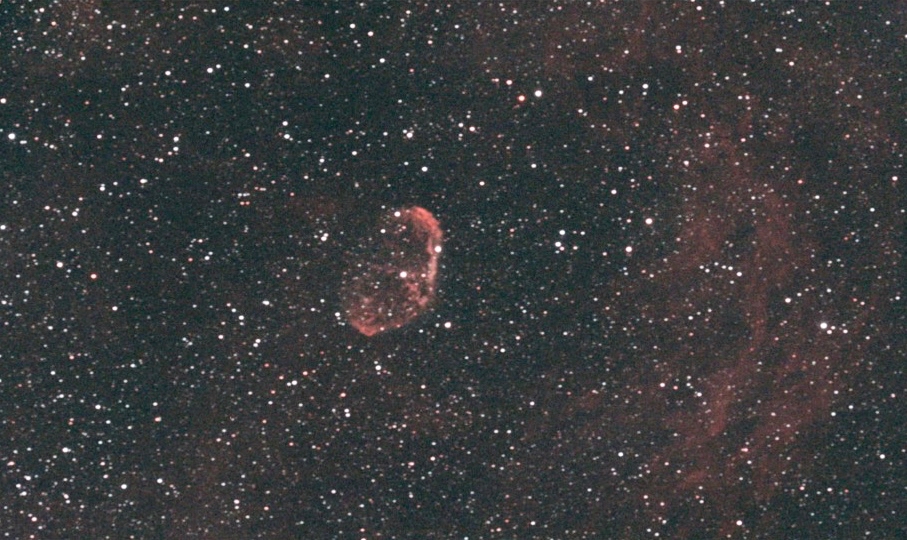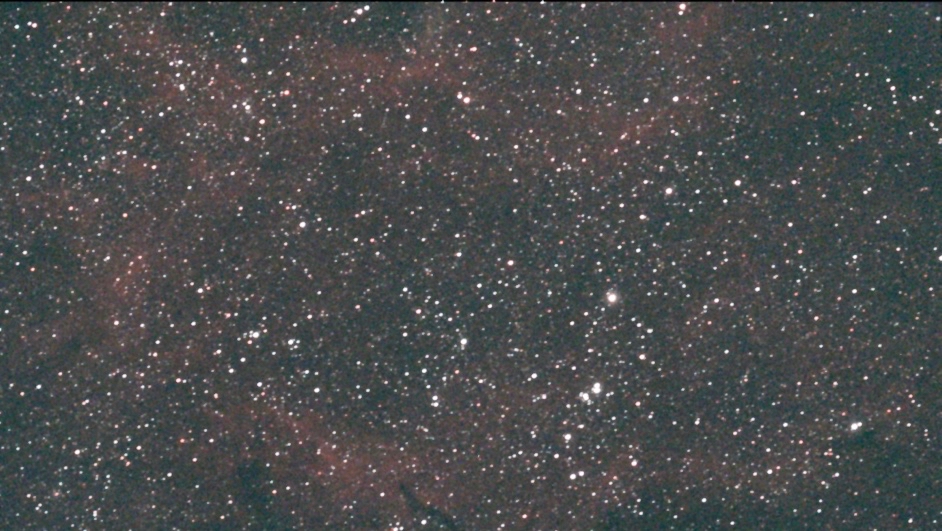
Like many constellations along the arc of the Milky Way, the constellation Cygnus harbors an embarrassment of celestial riches. There’s everything here: emission nebula, supernova remnants, open star clusters, star clouds, and dark nebulae that reach like intertwined fingers over the bright and unresolved star clouds in this part of the sky. In dark sky, with a pair of binoculars or wide-field telescope, a contemplative stargazer can spend many happy hours hopping from object to object, wondering why more people turn their eyes skyward more often.
Which is what I was doing on a cool northern autumn night as I toured the celestial Swan, looking for a handful of pretty emission nebulae that radiate a deep red light and stand out along the rich star field in this part of the sky. These nebulae make ideal targets for urban stargazers like me because their contrast is readily enhanced with a good light pollution filter which passes their emission while reducing the effect of urban light pollution. The nebula doesn’t appear brighter, but it does have better contrast against fish-grey urban and suburban skies.
Instead of visual observing, I left my eyepieces in the bag and instead engaged in a little ‘snapshot astrophotography’, taking simple image of each nebula in a few minutes to record my observations… and to share them with you!
The Eastern Veil Nebula
My chosen camera had a limited field of view, too small for the most famous nebula in Cygnus, the North America Nebula (NGC 7000, seen at top and image with a larger-sensor camera). So I began my observations where I always do in this constellation, with the Veil Nebula, an object so beautiful I can’t help myself to visit it whenever I tour this part of the sky. Tonight, I grabbed a quick image of the eastern Veil, NGC 6992, with its intricate lacework generated when a shockwave from a massive supernova explosion collided with the rarefied gas of the interstellar medium.

The Butterfly Nebula
While the Veil Nebula represents the end-stage of a star’s life, the Butterfly Nebula (IC 1318) lies at the other end of the ecological spectrum of star formation in the Milky Way. This massive complex lies near the star Sadr, named after the Arabic “Al Sadr al Dajāja” (the Hen’s Breast). With the camera, the nebula appears as two semicircles of reddish light bifurcated by LN889, a dark lane of dust that obscures further nebulosity behind it. This entire region is ablaze at infrared wavelengths in professional scopes, a consequence of bright new stars embedded in the gas of dust of this patch of Milky Way. Sadr itself is not of of these stars: it lies about 1,800 light years away while the Butterfly Nebula complex is nearly 5,000 light years distant. In the image above, the star cluster NGC 6910 lies to the right of the nebula

The Crescent Nebula
Two degrees further along the backbone of Cygnus towards the star Albireo lies the Crescent Nebula (NGC 6888). Here, a cloud of interstellar hydrogen gains energy from the young and energetic star WR 136, a so-called Wolf-Rayet star that’s some 600,000 times brighter than our sun. The arc-shaped cloud of hydrogen gas itself was likely blown off by the star some 250,000 years ago; the faster moving light and wind from the star has collided with the gas to set it aglow. Like most nebulae, the Crescent promises to be a short-lived object, astronomically speaking. The immense star WR 136 will surely blow up as a supernova in a few hundred thousand years. The remnant of the explosion may look something like the Veil Nebula in the subsequent millennia.

The Cocoon Nebula
In the other direction, north and west of the star Deneb at the tail of the Swan and halfway to the constellation Lacerta, I aimed my lens at the lovely Cocoon Nebula (IC 5146). The Cocoon is a typical stellar nursery, much like the brighter Orion Nebula, and harbors a small cluster of new stars born just 100,000 years ago. My telescope and filter mostly captured red light emitted by hydrogen, but there’s also a trace of blue starlight in this nebula reflected of interstellar dust. While the image below only shows a trace of it, more detailed images of the nebula show a striking column of coal-black dust off to the west which resembles a strand of fiber from which hangs the Cocoon Nebula itself. The dark nebula is cataloged as Barnard 168. The complex lies about 4,000 light years away.

I didn’t hit all the sights on my list this night. I hoped to capture the tiny Tulip Nebula about three degrees west of NGC 6888. But I only managed to capture the adjacent star cluster NGC 6871 and a little of its surrounding lacework of nebulosity. Sleep beckoned, so I hope for better luck next time.

A Note About Equipment –
The five previous astronomical ‘snapshots’ were captured with a dedicated Askar 200mm f/4 astronomical camera lens, the Askar ACL-200 along with a small ASI385MC astronomy camera from ZWO and an Optolong L-Enhance nebula filter. The field of view was about 2.1ox1.8o. The lot was mounted on a SkyWatcher AZ-GTi mount set up for equatorial operation, and all instruments were controlled with a ZWO ASIAIR-PRO operated with an iPad. With this set up, it took just 30 seconds to get an image on the screen. I stacked several such images of each object to reduce noise. This approach yields pretty good images quickly. Of course, far better images can be obtained using more time-consuming astrophotography techniques where it takes several hours of capture and processing time for each object.
All images on this page credit and copyright Brian Ventrudo/CosmicPursuits.com
Share This: